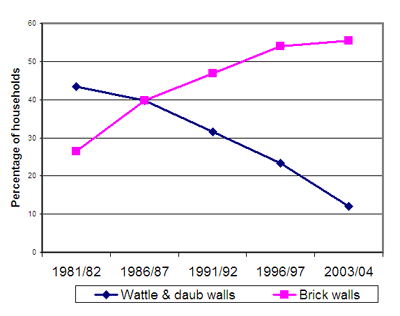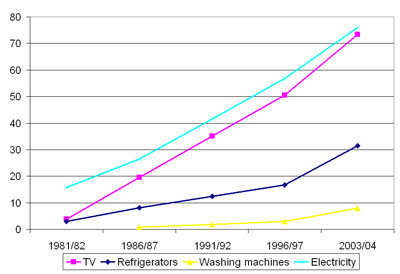October 23, 2006 (LBO) - Recently the government imposed tougher import conditions on non-essential items:
http://www.lankabusinessonline.com/sri-lanka-slaps-limits-on-non-essential-imports-to-curb-credit-growth/
Luxury goods according to the Government of Sri Lanka
| Palm Oil |
| Chocolates |
| Bread, pastry, cakes, biscuits and other bakers' wares |
| Beer |
| Wine, vermouth and other fermented beverages |
| Spirits, liqueurs and other spirituous beverages |
| Perfumes and toilet waters |
| Beauty or make up preparations (lip, eye, manicure, pedicure etc) |
| Preparations for use on hair |
| Pre-shave, shaving or after-shave preparations, personal deodorants and anti-perspirants, |
| Perfumed bath salts and other bath preparations, |
| Preparations for perfuming or deodorising rooms |
| Soap and organic surface-active products |
| Tableware, kitchenware, other household articles and toilet articles of plastics |
| Articles of apparel of knitted or crocheted |
| Footwear |
| Artificial flowers |
| Walltiles, floortiles and the like |
| Tableware, kitchenware, other household articles and toilet articles of ceramic, porcelain or china |
| Statuettes and other ornamental ceramic articles |
| Glassware of a kind used for table, kitchen, toilet, office, indoor decoration or similar purposes |
| Imitation jewelry |
| Tableware, kitchenware, other household articles of stainless steel |
| Locks and padlocks |
| Fans |
| Air conditioners |
| Refrigerators, freezers and other refrigerating and freezing equipment |
| Dish washing machines |
| Household and laundry type washing machines |
| Electro-mechanical domestic appliances, with self-contained electric motor (e.g., vacuum cleaners, floor polishers, food grinders, mixers, blenders etc) |
| Shavers, hair clippers and hair-removing appliances with self contained electric motor |
| Electric instantaneous or storage water heaters and immersion heaters |
| Hair dryers and other hair-dressing apparatus |
| Electric smoothing irons |
| Microwave ovens |
| Other ovens and cookers |
| Coffee or tea makers |
| Toasters |
| Video recording or reproducing apparatus, whether or not incorporating a video tuner |
| Television |
| Antennas |
| Filament bulbs and energy efficient compact fluorescent lamps and other lamps |
| Wrist watches and clocks |
| Lamps and light fittings |
| Toys |
Source: Central Bank of Sri Lanka
I was intrigued by the bureaucratic reasoning that must have gone into deciding what is essential and what is not. For many people wrist watches are essential, but they are considered inessential by the government.
Not being a user of hair dye, I can agree with the government's classification of "preparations for use on hair" as luxuries. I can also applaud the self sacrifice entailed in making this classification.
To me energy-efficient compact fluorescent lamps are absolutely essential, but apparently the government does not think so.
One part of government is running an advertising campaign encouraging people to use energy-efficient bulbs and another part declares them luxuries.
But this argument can go only so far. Is there a source of objective information that could be brought to bear on the problem?
Evidence
Common sense suggests that the essentiality of an item would be correlated to how many people use it. The Central Bank's Consumer Finance Survey provides some relevant data.
The government considers locks and padlocks a luxury.
It seems that the Central Bank's data on permanent walls in the country's housing stock has a bearing on this question.
Figure 1: Households with permanent brick walls, 1981-2004 (Source: Central Bank of Sri Lanka, Annual Report 2005
Notes: Data from 1986/87 onward exclude the Northern and Eastern
Provinces; Data for 1991/92 has been calculated.)
(Source: Central Bank of Sri Lanka, Annual Report 2005
Notes: Data from 1986/87 onward exclude the Northern and Eastern
Provinces; Data for 1991/92 has been calculated.) |
Figure 1 shows that there has been a significant improvement in the housing stock over the past 25 years, though growth of households with brick walls has slowed done somewhat after 1996/97.
Unless the government plans to produce locks and padlocks in government-owned factories or there is excess capacity in lock making factories in Sri Lanka, it is likely that a product that is needed by over 50 per cent of households will go up in price because the government has declared it a luxury good.
Many of the items on the government list are electrical appliances. Figure 2 shows what of these the Central Bank provides data on.
Figure
2: Households with electricity, TVs, refrigerators
and washing machines, 1981-2004
 (Source: Central Bank, Annual Report 2005)
(Notes: Figure 1 notes apply. The Ceylon Electricity Board states that
it gives electricity to fewer households than reported by the Central
Bank)
(Source: Central Bank, Annual Report 2005)
(Notes: Figure 1 notes apply. The Ceylon Electricity Board states that
it gives electricity to fewer households than reported by the Central
Bank) |
No TVs are manufactured in Sri Lanka. Yet, around 70 per cent of households have TVs. One could assume that a significant proportion also have DVDs or VCRs.
It appears that the government is applying some kind of moral judgment on TVs by declaring them luxuries.
What is likely to raise more than few eyebrows is how fast the use of refrigerators is growing.
In the Western Province, where around 30 percent of the population lives, 53.6 per cent of the households have refrigerators, more than those that have a telephone, fixed or mobile, in the house. I would not classify refrigerators as luxury goods.
Washing machines are also rapidly moving into households, from 3-percent of households in 1996/97 to 8 per cent in 2003/04. In the affluent Western Province, 17.8 per cent of households reported washing machines in 2003/04.
Explanations
So what can be the logic of the Chinthanaya declaring these items to be luxuries?
There are two possibilities. First, it may be that those who come up with these classifications already have the necessary electrical appliances in their homes and do not wish the hoi polloi to get them.
Second, it may be that this is part of the government's comprehensive plan to conserve electricity. If people are discouraged from buying electrical appliances, they can't use them. If they don't use them, electricity consumption will not go up.
There is the little matter of classifying energy-efficient bulbs as luxuries that threatens the logic of the second explanation, but no one claims that the government is perfect. You get what you pay for; or vote for.
The reader may choose an explanation; or come up with one's own.
Or get ready for the gradual reintroduction of import controls. This could be the thin end of the wedge in bringing back the failed policies of the SLFP that got them decisively rejected in 1977.
 (Source: Central Bank of Sri Lanka, Annual Report 2005
Notes: Data from 1986/87 onward exclude the Northern and Eastern
Provinces; Data for 1991/92 has been calculated.)
(Source: Central Bank of Sri Lanka, Annual Report 2005
Notes: Data from 1986/87 onward exclude the Northern and Eastern
Provinces; Data for 1991/92 has been calculated.) (Source: Central Bank, Annual Report 2005)
(Notes: Figure 1 notes apply. The Ceylon Electricity Board states that
it gives electricity to fewer households than reported by the Central
Bank)
(Source: Central Bank, Annual Report 2005)
(Notes: Figure 1 notes apply. The Ceylon Electricity Board states that
it gives electricity to fewer households than reported by the Central
Bank)